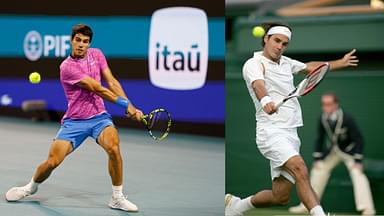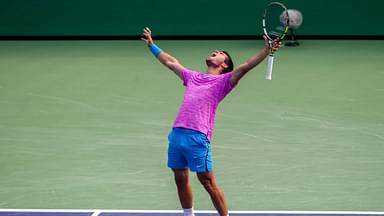Carlos Alcaraz wrapped up his Indian Wells 2024 campaign by defeating Daniil Medvedev in the final to retain his title. He had many highlight-worthy moments in the tournament. One such segment that stood out was when the Spaniard pulled out his version of SABR, the iconic Roger Federer tactic the Swiss star devised late in his career.
As the second seed, Alcaraz received a bye and began his tournament in the second round. He faced Matteo Arnaldi, beating him emphatically in three sets after losing the first (6-7(5), 6-0, 6-1). The entire match made for a great highlight reel but one stunning shot from the eventual champion stood apart.
With the first set level 3-3, Alcaraz had a breakpoint on Arnaldi’s serve. Standing outside the baseline, as most players do, the World No.2 burst ahead just as his opponent was about to serve. He made early contact, on the bounce, off his backhand. He did not stop, going up to the net to smash a winner off Arnaldi’s return, leaving the Italian stunned.
This tactic reminded fans of Roger Federer’s SABR (Sneak Attack By Roger). So much so, the official ATP account on X (formerly Twitter), shared the video of Carlos Alcaraz playing this point and called it SABC (Sneak Attack By Carlos).
While he may have lost the set, this surprise strategy worked well for Alcaraz. Arnaldi was taken aback, clearly not expecting his competitor to employ this high-risk high-reward tactic. Alcaraz did not use the ‘SABC’ again during the Indian Wells 2024. However, that perhaps helped the sneaky shot retain its shock value as a trump card. If he decides to bring out this plan during the Miami Open 2024, it will be a treat for everyone watching.
What was SABR, the Roger Federer tactic Carlos Alcaraz emulated?
Federer surprised the tennis fraternity when he showcased his new Sneak Attack By Roger shot in late 2015. It was not something completely novel, as many players in the 1980s followed a similar gameplay. However, back then, courts were quicker and similar strategies like serve-and-volley were the norm. In today’s game, though, it was revolutionary.
Roger Federer used the SABR to great success, winning the Cincinnati Masters 2015, the first tournament where he began playing this shot. He employed it on multiple occasions throughout the event. However, the most iconic instance came in the final against Novak Djokovic. The aim of the SABR is to receive the service on the rise, right after the bounce, to disrupt your opponent’s flow and throw them off guard.
A few players have tried their hands at executing the SABR, most famously Nick Kyrgios. Ironically, he once tried to use it on Federer himself, who effectively combated it. Now, after many years of such sneak shots missing from the tour, Carlos Alcaraz has seemingly brought it back.
Alcaraz’s first attempt was a great success, but now it remains to be seen whether he will pull off the trick at the Miami Open 2024. It is possible that if a successful player like Carlos Alcaraz would do so more often, others would follow suit and make Roger Federer’s wish of having more variety of shots in the modern game, to make it more interesting, come true.







